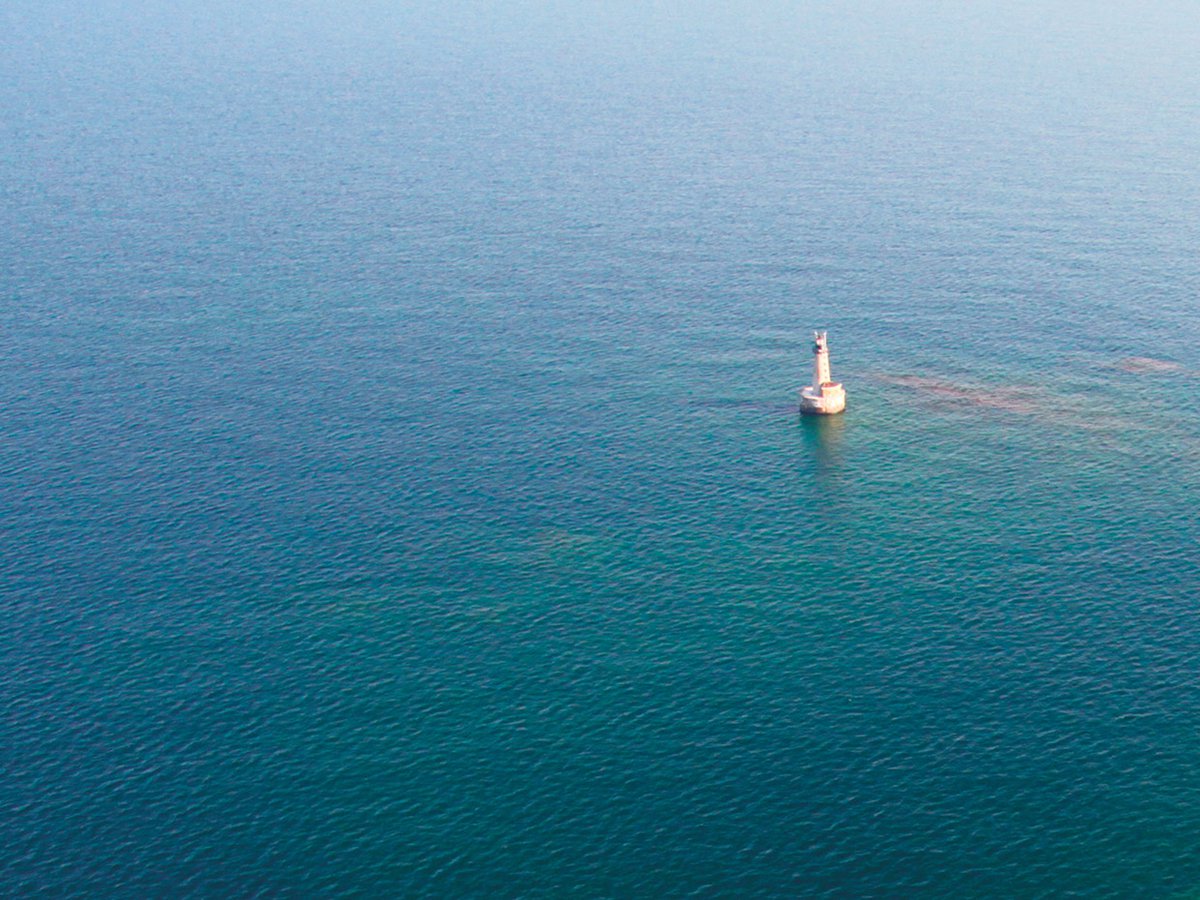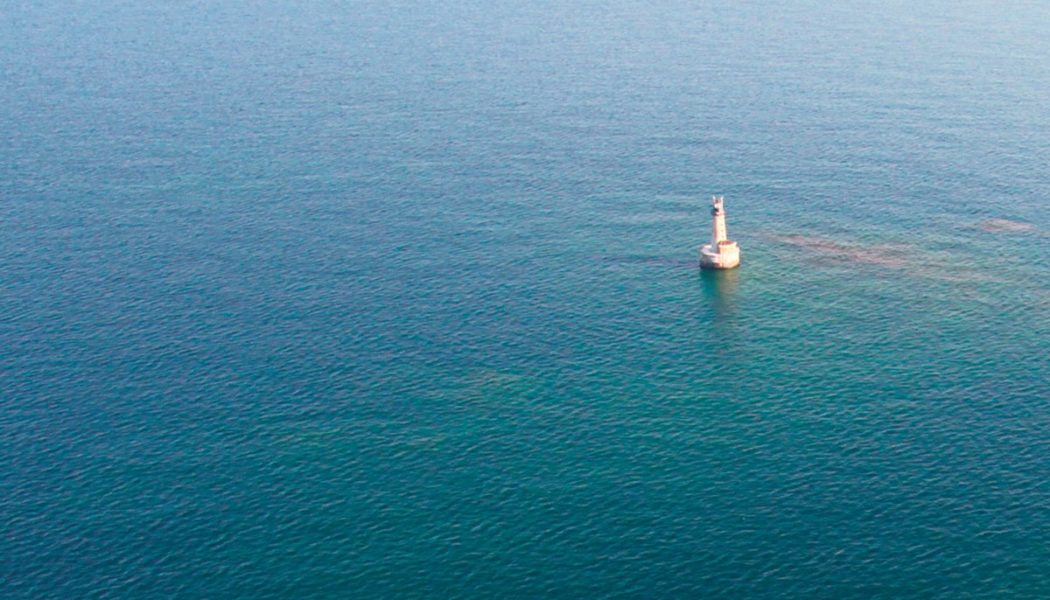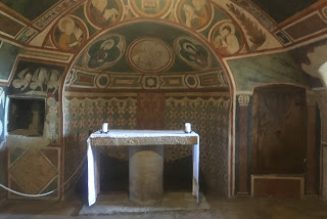
Old-time lighthouse keepers called it “the loneliest place in North America.”
Modern-day U.S. Coast Guardsmen at times labeled it “Stranded Rock” and rumored it was a punishment tour of duty, as in “If you screw up badly enough in the Ninth District, they will send your butt out to Stranded Rock.”
But professional lightkeeper or Coast Guard boot, all knew it as the North American light station the most distant from land, with Keweenaw Point 25 miles to the west and Marquette a long, rough 42 miles south.
The story of Stannard Rock Lighthouse is certainly among the most dramatic of any on Lake Superior. Split Rock, Copper Harbor, Whitefish Point or any of the Big Lake’s other beacons don’t stand as tall as the mighty citadel surrounded by water.
It was August 26, 1835, that legendary navigator Captain Charles C. Stannard discovered the reef on which the lighthouse stands today. Imagine his shock to stumble upon an unknown pinnacle so far from shore in waters thought to be clear of all hazards.
As maritime activity increased, the potential danger of the reef grew; it was just south of the Sault-to-Duluth shipping lane. Mariners dubbed it “one of the most treacherous reefs in the entire Great Lakes.”
The U.S. Lighthouse Service knew the reef needed a navigation light, but could a structure survive on a rock exposed to a 110-mile open sweep from the north-northwest during one of the Lake’s hell-spawned furies?
As a test on the shallowest part of the reef, the Lighthouse Service built a 12-foot diameter stone crib topped by a 20-foot high, 6-foot diameter iron day beacon. Only after that structure, built in 1868, survived storms and ice for a few years did engineers determine that a lighthouse could be built on the reef.
Construction of Spectacle Reef Lighthouse in northern Lake Huron also was critical to the Lake Superior lighthouse. Spectacle Reef was remote, about 30 miles east of the Straits of Mackinac, 10 miles from the nearest shore. It also would face severe storms and shifting ice. Once lighthouse engineers finished the relatively easy build at Spectacle Reef, the crew would be trained and ready to tackle the monster project at Stannard Rock.
When Spectacle Reef was finished in 1878, the equipment developed for the project, as well as the construction crew, shifted to Lake Superior. A base camp called “Stannardsville,” established near Skanee, Michigan, 51 miles southwest of the Rock, included barracks, offices, workshops, docks and storage.
It took five long, difficult years and a cost of more than $300,000 to build the lighthouse. Every spring, repairs had to be made to the previous year’s work because of winter storm and ice damage. At times the men felt they did more repairing than building. Summer storms drove the crews off the Rock, further slowing construction. During the 1878-79 season, the crew was only able to work 61 percent of the time because of storms.
After building a massive concrete base known as a crib in 11 feet of water, they started on the tower.
The tower’s sandstone blocks, weighing 12 to 30 tons each, were quarried at Kellys Island on Lake Erie and brought to Stannardsville by barge. To be certain every block fit before being transported, the entire tower was built on shore, then hauled out to the reef piece by piece and reassembled. Huge, iron drift pins secured each course of blocks to the one below it.
The tower has seven levels, from the galley, or kitchen, at the base level up through the sleeping quarters, library-reading room, watch and lens rooms. Walls at the base are 7.5 feet thick, tapering to 22 inches at the lens room.
A fog-signal building for the engines, boilers and two 10-inch steam whistles and boat cranes were also constructed on the concrete crib deck. More than 240,000 tons of rock, iron and steel assured the lighthouse was built to last for centuries.
The new light was first illuminated July 4, 1882, a classic 19th century tower standing tall and proud against the empty lake and sky.
A second-order beehive (classical) Fresnel lens with 12 bull’s-eye prisms sent a beam pattern 25 miles out.
The old keepers told terrible tales of life on the Rock. Violent northwest storms sent 30-foot waves smashing into the tower and spray cascading over the lantern room 110 feet above the Lake, pounding the tower violently enough to knock cans off shelves and plates from tables. When keepers had to go out from the galley at the base of the tower during high winds, they tethered themselves with rope to be certain they would not be blown away.
Returning in spring, keepers frequently found the base heaped high with ice, requiring them several times to chop their way with axes through ice 10 feet thick. Sometimes the boats carrying them struggled over half a mile of Lake ice just to reach the station. One year there was so much ice on the Lake, keepers didn’t reach Stannard Rock until July.
Removing keepers in fall also often meant battling freezing gales. In 1913 the entire tower was encased in 12 feet of ice by a vicious north gagger. It took a 12-man rescue crew with axes and steam lines a week to free the keepers.
Unlike many lighthouses where keepers’ families lived, the Rock remained a stag station, a complete male society without distractions of wives, girlfriends or children. There was lots of card playing. John Juntti of Ishpeming, Michigan, was stationed at the Rock in the 1950s as a 20-year-old Coast Guardsman. He remembers playing “a lot of cribbage.” Cooking was simple with each man on his own, usually settling for whatever came out of a can. The men went for days without talking; there just wasn’t anything to say.
In 1882, the first lightkeeper at Stannard Rock was John Pasque, transferring from Sturgeon Point Light on Lake Huron. Why he left such a pleasant station for the bleak solitude of the Rock isn’t known, but he lasted less than a year before transferring to Michigan Island in the Apostle Islands.
The first year was difficult for assistant keepers, too. The light was authorized three assistants, but six came and quickly went. After assessing the bleak surroundings, three quit the Lighthouse Service outright and a fourth made it a bare three weeks before quitting.
The longest-serving keeper was Louis Wilks from Marquette, who held the job from 1936 to 1956. He also holds the record for consecutive time spent on the Rock – 99 days. No other keeper even approached this remarkable feat. To combat the terrible isolation, the men were rotated off the Rock, typically three weeks on and one off.
From the old employment records, it is plain that many men were driven off the Rock by the extreme isolation. Marooned on a concrete and limestone pinnacle, out of sight of land, with nothing but the mocking cry of gulls and the relentless crash of the cold waves, was a situation many found unbearable. The Rock wasn’t for them. But for others, like Wilks and his long-time assistant Elmer Sormunen, seemed to thrive in the isolation. Sormunen worked there from 1934 to 1954.
When the U.S. Coast Guard took over the lighthouses in 1939, overwhelming loneliness was a problem for its men, too. Some of the new Coasties were ill prepared to face the devastating solitude.
According to unverified legend, in the 1940s one Coastie was carried off the Rock in a straitjacket. A decade later another called on the radio to the Marquette Coast Guard station and threatened that if the boat didn’t come out and get him immediately, he “would start swimming.” Other men refused to return to the lighthouse after their leave, they would go AWOL (absent without leave) or accept a court martial. To deal with this morale problem, at one point the Coast Guard limited the assignment to a single season and allowed the men to select their next assignment.
Tragedy struck the Rock on June 16, 1961. Four men were assigned to the lighthouse – 35-year-old Engineman 1st Class William Maxwell, 22-year-old Seaman Walter Scobie and 18-year-old Seaman Richard Horn. The officer in charge, 34-year-old Boatswain Mate Walter M. Patterson, was on leave. In addition, 23-year-old Electrician’s Mate Oscar Daniels was present to work on the automation of the light, since 1961 was to be the last year it was manned.
At 9:30 p.m. more than 1,000 gallons of gasoline stored in the engine house for electric generators exploded with massive force, rocking the tower, blowing Scobie out of his bunk and slamming Horn and Daniels against the galley wall. The resulting fire ignited propane tanks and the coal bunker. The roaring flames blocked the only door out of the tower and sent smoke and heat up through it like a giant chimney. The fire was so hot that part of the limestone near the engine house melted.
Maxwell, on watch during the disaster, was killed outright by the blast. A native of Houghton, Michigan, he left a wife and four children.
Unable to flee the tower through the fire-blocked door, the three survivors broke out a lower level window and climbed out to the open crib deck.
They were confident of a quick rescue. Periodic radio checks were made with both Marquette and Manitou Island Coast Guard Stations. When they didn’t make contact, it would surely be realized that something had happened. And, of course, surely someone would notice the light was out.
Their confidence was misplaced. Apparently neither Manitou Island nor Marquette Stations was suspicious when the checks were missed, and no one reported the light beacon wasn’t working.
All the men could do was huddle out on the windswept crib with only an old tarp for shelter.
Two days later the Coast Guard Cutter Woodrush was approaching the light on its regularly scheduled trip when a lookout noticed the black smoke, which was still pouring out of the tower. The cutter quickly rescued the three survivors, extinguished the fire and rigged the winter lamp for the rest of the year.
Old keepers just shook their heads. This was no way to leave a light for the last time. The last watch was stood, but not finished.
The explosion’s cause remains uncertain. The general belief is gasoline fumes were ignited by machinery defect or human error.
The following year, the light was automated and the massive Fresnel lens removed and replaced with a small plastic optic. The Fresnel lens was packed up, taken to the Coast Guard station at the Soo and then strangely lost. For more than 30 years, it was just missing, the Coast Guard having no record of it. In 1998 it was discovered in the basement of the Coast Guard Academy in New London, Connecticut. How it got there is unknown.
In September 1999, a loan agreement between the Coast Guard and the Marquette Maritime Museum was reached and volunteers returned the lens by truck to Marquette. After great effort, it was reassembled and now shines like a giant diamond, a jewel of 19th century technology. Standing more than 10 feet tall, it is one of the five largest lenses ever used on the Great Lakes.
Because it is so far offshore and because the Lake has a propensity for weather to change quickly for the worse, Stannard Rock is certainly one of the least visited lighthouses on the Great Lakes. Most lighthouse buffs never have a chance to see it, let alone actually explore the tower.
While it is possible to moor a small boat alongside the concrete crib, calm weather is required. Access to the deck is by a 22-foot steel ladder slimy with sea gull deposits. The light is still active and a battery-powered optic with solar replenishment and a NOAA weather station grace the top level. In 2015, ownership of the lighthouse was transferred to the Superior Watershed Partnership, which “plans to expand Great Lakes climate research at the lighthouse and involve the Great Lakes Conservation Corps in historic renovation projects.”
The destruction to the fog house from the explosion was massive. Climbing up the winding stone stairs to the lantern room is downright spooky, each level pulling the visitor farther back into the era of the old-time keepers. Still, for those privileged to see it, the view from the galley outside the lantern room is spectacular. On a clear day, the mountains on the Keweenaw Peninsula are visible to the west, as are the Huron Mountains to the southwest. Looking north, the shallows of the dreaded shoal sparkle as clear as a coral reef from the Caribbean Sea. Gulls wheel and turn, objecting strenuously to the invasion of their home. The light is truly a place time forgot.
Forgot, that is, except for the sport fishing that thrives there.
The reefs around Stannard Rock are a prolific breeding ground for lake trout. During the heyday of commercial fishing, Marquette tugs regularly pulled rich harvests from the lonely reefs. Some lightkeepers set a net or two and bartered their catch to the fish tugs for a couple of bottles of redeye, especially during the dark days of Prohibition.
On any good weather day in summer, a small fleet of sport-fishing boats eagerly works here to catch the special lake trout that call the Rock home. According to Bill Duckwall of Uncle Ducky’s Charters in Marquette, “Beyond a doubt, the reef is the best lake trout fishing in the Midwest.”
The reef is famous for a lunker lake trout in 1998 yielding the Michigan state record of 61.5 pounds.
As to navigation, the great age of lighthouses is past. Today the towers remain mostly as monuments to a bygone maritime age. Whether their beams cut through the dark of night is no longer important to commercial and most recreational vessel navigation. GPS and radar now guide the mariner to a safe course.
But lure and the mystique of lighthouses continue to enchant mariner and land-lovers alike. Even as far away as Stannard Rock at the Loneliest Place in North America.
The Standard for Stannard’s
There is some confusion about the name of the lighthouse. Historically the reef was called “Stannard’s Rock” based on Charles Stannard’s discovery. The original name of the lighthouse was therefore Stannard’s Rock. About 1910, for reasons that are unclear, but perhaps the government clerks ran out of apostrophes, “Stannard Rock” began to appear in all of the official Lighthouse Service publications. Some post 1910 records also show it as Stannard Rock or even Standard Rock. In this story, I’ve deferred to the nautical chart appellation (just as this magazine uses the nautical spelling for St. Marys River without an apostrophe), but I believe the correct name is Stannard’s Rock as it best honors both the discoverer and original lightkeepers.
Frederick Stonehouse is a renowned maritime historian and author of more than 30 books, including our own popular Haunted Lakes series. Fred has visited the Stannard Rock Lighthouse several times.
Join Our Telegram Group : Salvation & Prosperity









